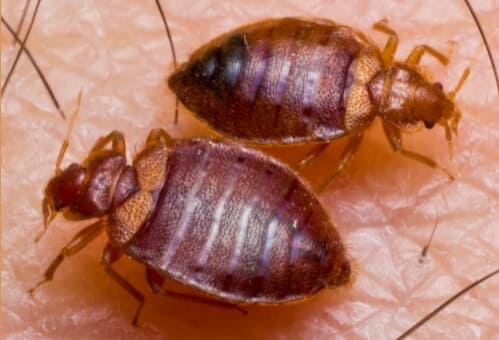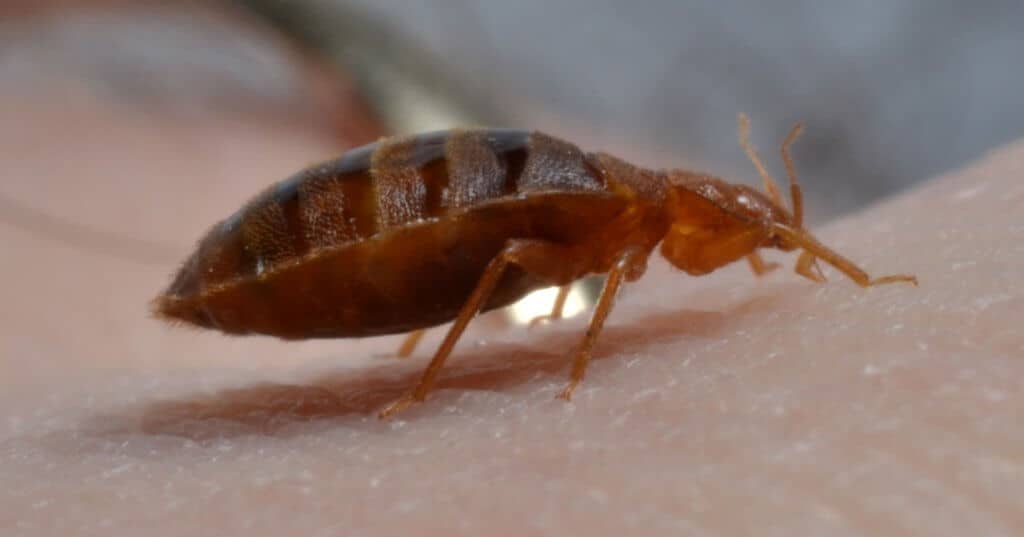“Goodnight! Sleep tight! Don’t let the bedbugs bite!” This phrase might be cute and fun to say, but when 1 out of 5 Americans experience or encounter an actual bed bug infestation, the phrase takes on a different meaning. Here’s a guide on what they are, how to know when they’re in your home, and how to get rid of them permanently. Then, you’ll never have to worry about that cheesy saying again.
What Are Bed Bugs?
Bed Bugs, or scientifically, Cimex lectularius, are tiny parasites that feed off of human blood. Adult bed bugs are small, brown, and flat oval-ish insects that will typically be the size of an apple seed. They can also look reddish, naturally occurring after a recent feeding.
Maturing nymphs, or baby bed bugs, take as little as a month to reach their full potential. After that, they need multiple feedings before they shed their skin five times to achieve their final form. Once they’re fully mature, bed bugs can travel pretty quickly over surfaces like walls, floors, and beds and can reproduce by female insects laying eggs throughout your entire home.
Where Do They Come From?

Essentially, bed bugs come from other infested places. They do not live in colonies or nests but tend to live in clusters or groups once they’ve become established in their hiding spot. They can travel by hiding in luggage, used box springs and mattresses, used couches, even on someone, creating a new home in yours. In the first few weeks to a month, because they live solely on blood, they’ll usually stay within 10 feet of where someone sleeps, naps or sits for extended periods. Afterward, they’ll move outwards to other hiding places in the house until they next need to feed. The key is to catch and eradicate the infestation before this happens to prevent future infestations.
How do I Know I Have an Infestation?
How do you know if you have a bed bug infestation or not? There are two critical methods in checking for bed bugs: looking for skin irritation after sleeping and visually inspecting for bugs.
Skin Irritation

Although Bed Bugs are not known to carry diseases, but they still primarily feed off blood. This means that during the night, while humans or animals are asleep, they will come out of their hiding spots to bite and suck blood from their hosts. Just like mosquitos, they have a beak that pierces the skin to drink blood from a person or animal. The best way to recognize the irritation is to see if you go to bed and wake up with itchy areas that weren’t itchy before. The spots are red and easily mistaken for mosquito bites, so be extra attentive. Once you’ve decided you might have a bed bug infestation, it’s essential to heed the next steps for visual cues of an infestation.
Visual Recognition

After feeling the physical indicators of a bed bug presence, the next step is to find and identify the bugs yourself visually. Most indicators consist of the following phenomena: blood stains in your bedding, rusty-colored areas in your bedding, on your mattress or your walls, shed skin or shells in/around your bedding, a foul smell around your sleeping area or furniture, specifically when there are dark spots around as well.
The best way to find their hiding spot to check these visual cues is to strip all bedding from your bed and check all crevices and hiding places a bug might call home. This could be in the box spring, underneath the mattress, in the corners of the bed frame, etc. Also, check bedside tables, inside outlets, and even clothing. Then, for greater peace of mind, call an experienced exterminator who will know what signs to look out for.
What are the Ways to Treat a Bed Bug Infestation?
In a Home

Options for treatment include freezing, heat, steam, vacuuming and insecticides. Freezing, steam and vacuuming are mostly going to affect the adults and will only impact those in the spots where this method is performed. Heat treatments can quickly knock down the population but cannot be done effectively in homes with lots of cracks and heat treatments are very expensive and leave no residual control for any stragglers. Drying your bedding on high heat for 20 minutes will help take care of any that may be on those at the time. Any other types of heat beyond that is not recommended to be done by a homeowner because of the risk of damage to your home including fire. There is also limitations with insecticides available to homeowners over the counter.
Other tips include using a brush and rag to scrub seams of mattresses, bed frames, headboards, and other hiding places before vacuuming all disturbed areas. If vacuuming, it is imperative to seal the vacuum’s contents in a Ziploc bag before disposing to prevent further infestations.
For future prevention, get rid of clutter around the bed, vacuum frequently, zip mattresses in heavy-duty mattress covers for at least a year, and repair all cracks or crevices in walls where bed bugs might hide.
Permanent Treatments

Although at-home tricks are helpful in the prevention of bed bugs and for killing adult bugs, there are no fool-proof at-home prevention tricks to ensure all eggs and nymphs are eradicated throughout the home. The best way to ensure a complete infestation clearing is to employ a professional pest control company. They are experienced in the field and know exactly what hiding places to look for, what behavior to look for, and how to permanently eliminate the pests. Usually, pest control companies will disperse products that kills and control eggs, nymphs, and adults, but every situation is different. It could be as simple as a phone call to get your bed bugs under control.
Conclusion
A bed bug infestation can be stressful and confusing if you don’t know what to look for and aren’t informed about the insects themselves. With these tips in hand, you can decide what to do if you’re experiencing this pest problem and what actions to take.

